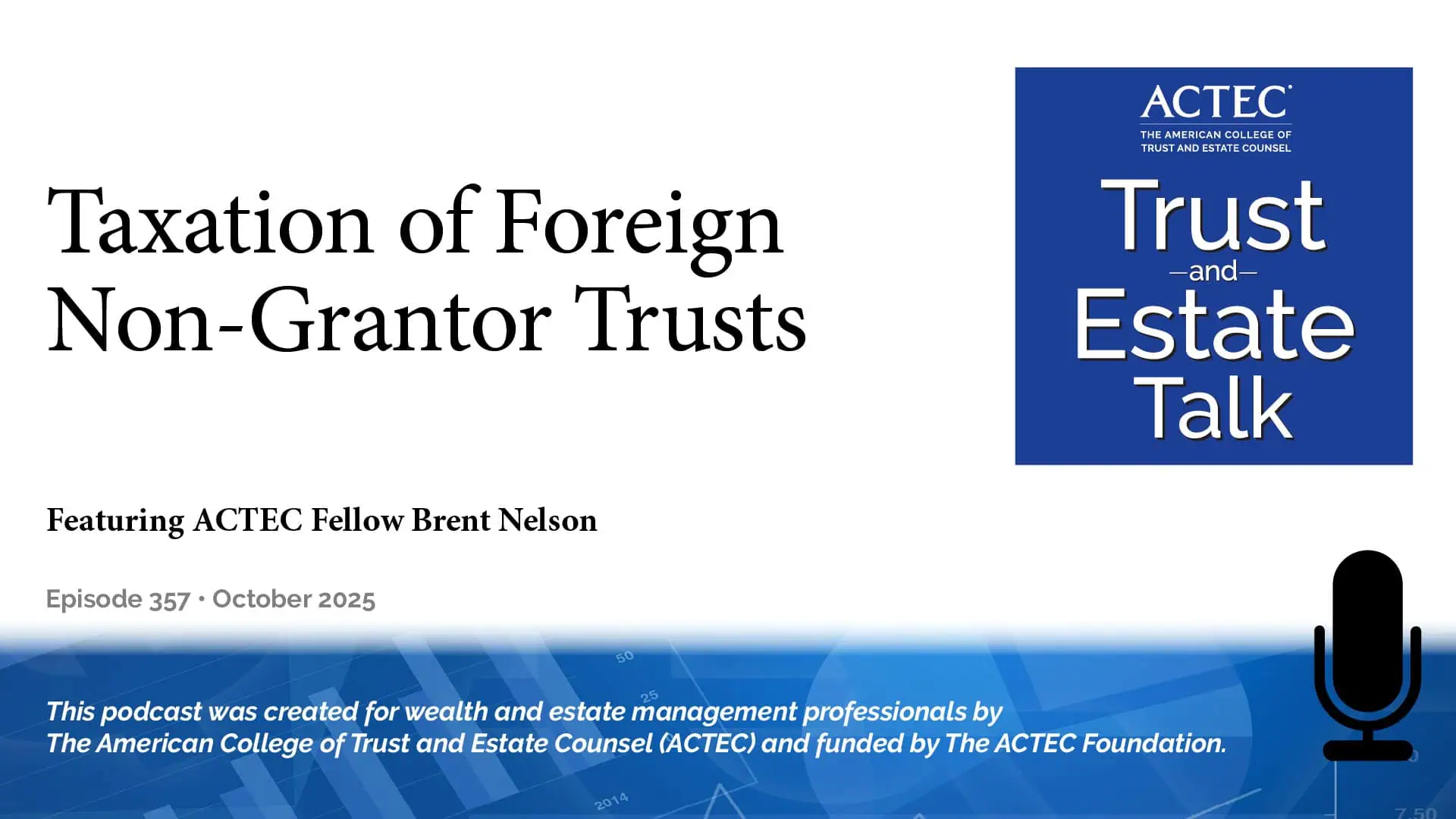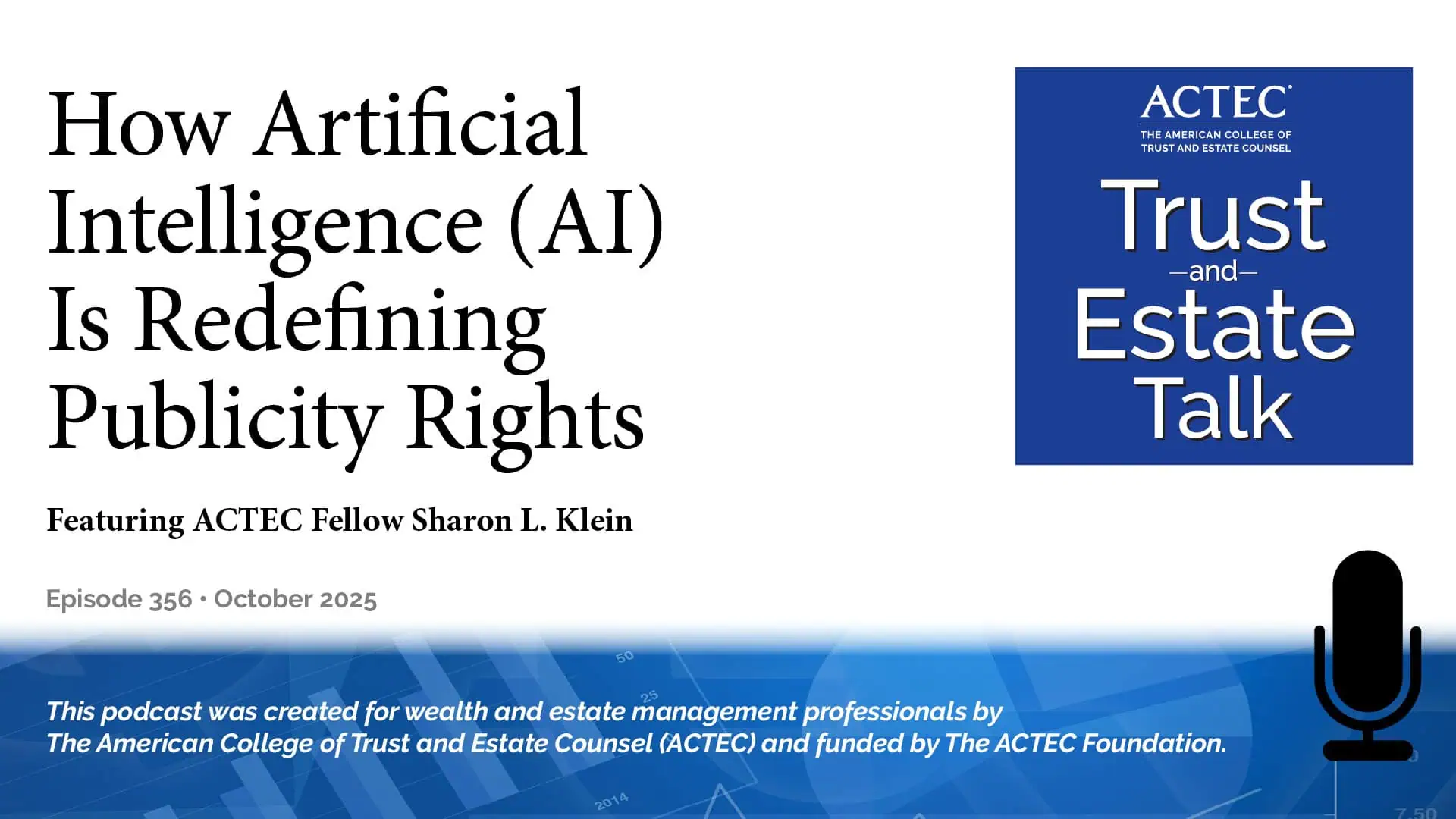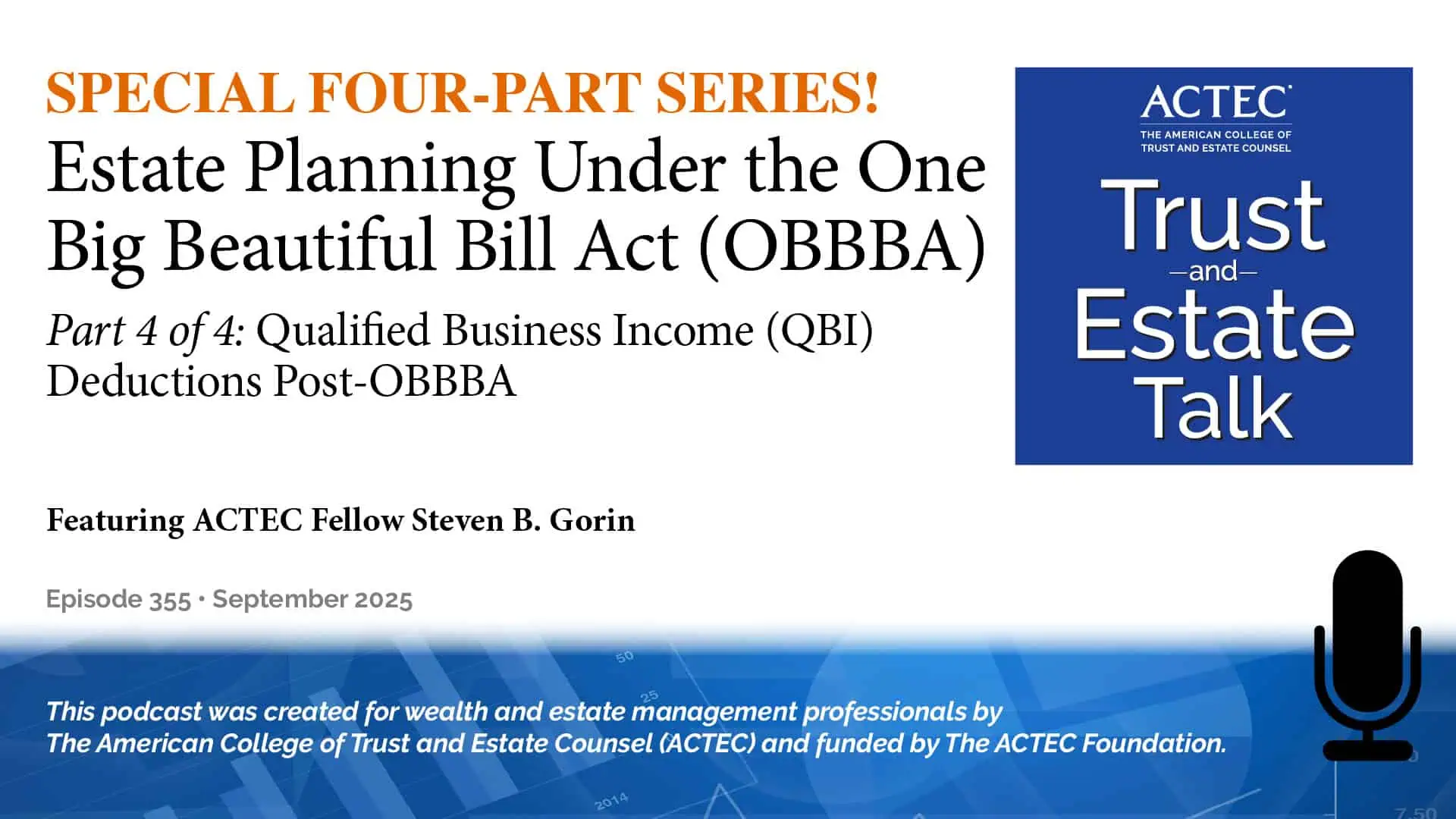The New Undue Influence
“The New Undue Influence,” that’s the subject of today’s ACTEC Trust and Estate Talk.
Transcript/Show Notes
This is Travis Hayes, ACTEC Fellow from Naples, Florida. Undue influence occurs when wrongful changes to a will or testamentary instrument have occurred due to a person obtaining a bequest or benefits by overriding the volition of a vulnerable testator or settlor.
Professor David Horton of the University of California Davis School of Law and Professor Reid Weisbord of Rutgers Law School, who are both ACTEC Fellows, join us today to share their insights from their joint article entitled, “The New Undue Influence,” which was recently published in the Utah Law Review. Welcome Professor Horton and Professor Weisbord.
Understanding Undue Influence
Professor Reid Weisbord: Thanks, Travis. This is Reid Weisbord speaking. Professor Horton and I would like to talk about new developments and fresh empirical findings on the ancient common law doctrine of undue influence. That concept was imported by American courts from England in the 1800s to deal with the problem of wrongful interference in the donor’s estate planning process. Most practitioners are familiar with the doctrine, which sets aside gifts procured by a soft form of coercion in which a wrongdoer exploits a position of trust, reliance, or dominance with the donor. To establish undue influence, a contestant must show that the wrongdoer subverted the donor’s subjective intent, but proof of that fact can be difficult to reconstruct with evidence after the donor’s death.
Most states assist contestants through a procedural mechanism by permitting a mandatory inference of undue influence that shifts the burden of persuasion to proponents to rebut the presumption of wrongdoing. Most practitioners are familiar with the elements for raising an inference of undue influence – proof of a confidential relationship between the alleged wrongdoer and donor, plus suspicious circumstances surrounding the transfer. For presumptively confidential fiduciary relationships, this burden-shifting system makes life much easier for contestants who only need to induce factual proof of suspicious circumstances.
The Economic Dynamics of Undue Influence Litigation
However, for relationships that are not presumptively confidential, contestants must undertake a deep evidentiary dive into the facts to prove the actual nature of the relationship between the wrongdoer and the donor. Proving that sort of long-term relationship dynamic between two humans – one of whom is usually dead at the time of litigation – can be a real evidentiary hurdle for contestants. So, in our empirical research, we wanted to take a closer look at just how often contestants are forced to muster factual proof of a confidential relationship and what happens in cases where the inference of wrongdoing is not presumed from a fiduciary relationship.
Another aspect that we wanted to examine was the economic incentives of undue influence litigation. Under the common law doctrine, prospective undue influencers have relatively little to lose from attempting to perpetrate an undue influence scheme. If they exert undue influence and no one contests, then they wrongfully inherit with minimal or no transaction costs. If someone does contest, then the wrongdoer might have to pay the costs of defending the donative instrument, but some courts have even allowed unsuccessful proponents to recover their litigation costs from the estate. Even if the wrongdoer has to pay for litigation to defend the instrument without reimbursement from the estate, that cost could be factored into the expected economic returns from the overall wrongful scheme.
The Impacts of Legislative Changes
Because the prevailing American rule in attorney’s fees requires contestants to bear their own litigation costs, prospective undue influencers have much to gain and relatively little to lose. A growing number of state jurisdictions, however, have begun to alter the economics of undue influence litigation by enacting elder abuse legislation that authorizes prevailing contestants to collect punitive damages and attorney’s fees unavailable under the common law.
In California, for example, a person who commits undue influence in bad faith is liable for statutory double damages plus reasonable attorney’s fees and litigation costs. Because it’s difficult to conceive of an undue influence scheme perpetrated in good faith, all contestants have to do to supersize their damages claim is include an allegation of bad faith. Interestingly, in 2013, when the California legislature was considering this reform, the T & E Section of the State Bar opposed the imposition of a double recovery remedy, citing the difficulty of proving the victim’s donative intent after death and the emotionally charged nature of estate litigation. In a policy statement to the legislature, the State Bar argued that raising the bar in an already difficult situation even higher will make these fraught cases even more difficult to settle and further burden the courts.
Professor Horton and I sought to assess that claim empirically by examining a large dataset of undue influence cases filed after the 2013 legislation went into effect. I’m going to turn it over to Professor Horton to talk about our empirical findings.
Professor David Horton: Thanks, Professor Weisbord.
Empirical Findings
We were really curious about the impact of what we call the “new undue influence” on case outcomes. And to be clear, by the new undue influence, we mean one of three things.
- One, special presumptions of undue influence that apply to bequests to certain types of people like drafting attorneys and caregivers.
- Two, civil claims for elder abuse by undue influence.
- And three, requests for double damages and attorney’s fees, as Professor Weisbord described.
The goal of these laws is to walk a tightrope between encouraging contests and, therefore, deterring elder abuse, but also not making the hammer so large that you have tons of frivolous litigation coming out of the woodwork. So, we analyzed a hand-collected data set of 6,817 probate and trust matters from California. And California is an ideal jurisdiction to study for two reasons – for one, as Professor Weisbord mentioned, it has been a trailblazer in passing new undue influence legislation. Indeed, it recognizes all three forms of the new undue influence that I described. Also, California requires probate courts to approve most settlements, which means that settlement agreements actually appear in the court record. A fact I’ll say more about later.
Out of these almost seven thousand probate and trust matters, we found 175 trial-level undue influence cases, including 100 that involved the claim under a new undue influence statute. At first, this kind of surprised us because we expected to find more new undue influence claims. After all, to request double damages and attorney’s fees, all you need to do is allege that undue influence was committed in “bad faith.” It’s hard to imagine how undue influence could be committed in anything other than bad faith.
Nevertheless, the rate of new undue influence claims among all undue influence claims was only 57%. In addition, we found that no contestant in our data actually recovered any of the new potent remedies that California has created in undue influence contests. Only nine undue influence matters proceeded to a verdict. Eight of them ended in a bench trial, and the alleged wrongdoer won every time. Nevertheless, when we dug deeper, we did see that the new undue influence legislation is leaving an impact.
121 cases in our data set settled. And here’s where California’s approach to settlement agreements came in handy. In 57 settlements, we were able to access the terms of the agreement and calculate a variable that we called the “success rate.” This success rate is the amount that a contestant recovered in the settlement agreement divided by the amount that they would have won if they had prevailed in a trial on the merits.
When we compared the success rate in cases involving an allegation of new undue influence with the success rate in cases merely involving an allegation of common law undue influence, we found that new undue influence contestants received more by a statistically significant margin. As you would expect when you think about it, the new undue influence doctrines do seem to increase the expected value of contests. But, as our research also suggests, the doctrine seems to do so in a way that doesn’t necessarily encourage frivolous litigation or saddle alleged wrongdoers with crippling liability.
Travis Hayes: Thank you, Professor Weisbord and Professor Horton for discussing your informative and thoughtful article regarding the “new undue influence.”
Professors Weisbord and Horton’s article is available in the Social Science Research Network, SSRN, eJournal. Subscriptions are available for free courtesy of The ACTEC Foundation.
You may also be interested in:
Latest ACTEC Trust and Estate Talk Podcasts

Taxation of Foreign Non-Grantor Trusts
Learn how U.S. tax rules affect foreign non-grantor trusts and discover key strategies for cross-border estate planning and compliance.

How Artificial Intelligence (AI) Is Redefining Publicity Rights
Explore how AI, deepfakes, and digital replicas are reshaping publicity rights, estate planning, and legacy protection.

Qualified Business Income (QBI) Deductions Post-OBBBA
Learn how the One Big Beautiful Bill Act changes the Qualified Business Income (QBI) Deduction, expanding phase-in ranges and tax planning opportunities.



